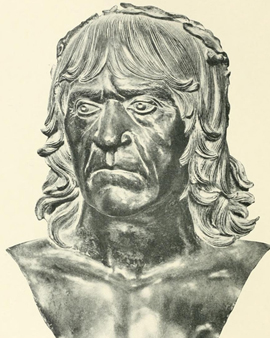


The Italian painter and engraver Andrea Mantegna is one of the most important painters of the early Renaissance in Northern Italy. He came from a simple background and worked as a cattle herder in his younger years. However, his talent for drawing was discovered early on and Mantegna went to study at a painting school in Padua. At Francesco Squarcione he learned to draw antique sculptures. The works of the sculptor Donatello also influenced the young painter. Mantegna's first work was a large altarpiece in a church in Padua. In 1447 the painter separated from his teacher in a dispute.
Mantegna then entered the service of various patrons and produced some important works. Together with an assistant of Donatello he worked on frescoes in the Hermitage Church in Padua. Mantegna rose to the position of court painter to Ludovico Gonzaga in Mantua. At the same time he also took on commissions in Rome, Pisa and Florence. Through Mantegna's painting Mantua became at times the centre of the fine arts. Mantegna's reputation as an important artist finally led the painter to the court of Pope Innocent VIII to paint a chapel above the Vatican Palace. Today this area is known as the Belvedere. There, however, the painter felt restricted in his artistic freedom and returned to Mantua.
Andrea Mantegna's painting shows the art of the Florentine school, which he brought to perfection. Mantegna's depictions are powerful and resemble works of sculpture. His depictions of individuals and architecture clearly show the influence of antiquity. The painter used perspective in his frescoes. He works out the anatomy of his figures with a trained eye. Mantegna's main works include the high altar of San Zeno in Verona, on which he worked from 1456-1459. A few years later, Mantegna painted the Camera degli Sposi in the Castello di San Giorgio in Mantua. For the first time, the painter created a group portrait and an illusionistic ceiling painting that simulated a view of the outside world. Mantegna was considered a talented engraver. His engravings can be seen today in important museums. Andrea Mantegna died in Mantua in 1506. Many of the painter's frescoes were damaged or destroyed during the Second World War.

The Italian painter and engraver Andrea Mantegna is one of the most important painters of the early Renaissance in Northern Italy. He came from a simple background and worked as a cattle herder in his younger years. However, his talent for drawing was discovered early on and Mantegna went to study at a painting school in Padua. At Francesco Squarcione he learned to draw antique sculptures. The works of the sculptor Donatello also influenced the young painter. Mantegna's first work was a large altarpiece in a church in Padua. In 1447 the painter separated from his teacher in a dispute.
Mantegna then entered the service of various patrons and produced some important works. Together with an assistant of Donatello he worked on frescoes in the Hermitage Church in Padua. Mantegna rose to the position of court painter to Ludovico Gonzaga in Mantua. At the same time he also took on commissions in Rome, Pisa and Florence. Through Mantegna's painting Mantua became at times the centre of the fine arts. Mantegna's reputation as an important artist finally led the painter to the court of Pope Innocent VIII to paint a chapel above the Vatican Palace. Today this area is known as the Belvedere. There, however, the painter felt restricted in his artistic freedom and returned to Mantua.
Andrea Mantegna's painting shows the art of the Florentine school, which he brought to perfection. Mantegna's depictions are powerful and resemble works of sculpture. His depictions of individuals and architecture clearly show the influence of antiquity. The painter used perspective in his frescoes. He works out the anatomy of his figures with a trained eye. Mantegna's main works include the high altar of San Zeno in Verona, on which he worked from 1456-1459. A few years later, Mantegna painted the Camera degli Sposi in the Castello di San Giorgio in Mantua. For the first time, the painter created a group portrait and an illusionistic ceiling painting that simulated a view of the outside world. Mantegna was considered a talented engraver. His engravings can be seen today in important museums. Andrea Mantegna died in Mantua in 1506. Many of the painter's frescoes were damaged or destroyed during the Second World War.
Page 1 / 5






